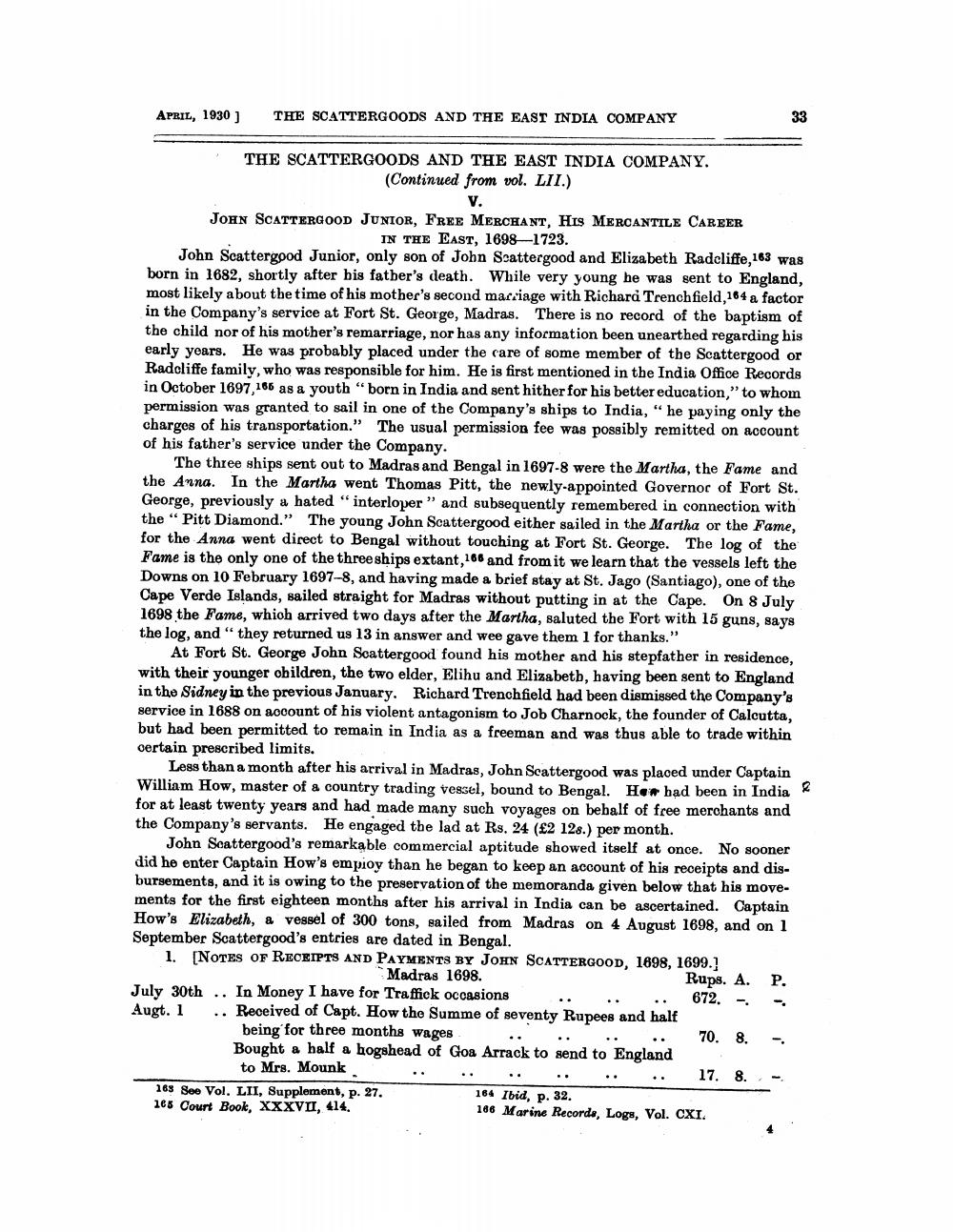________________
APRIL, 1930 ]
THE SCATTERGOODS AND THE EAST INDIA COMPANY
33
THE SCATTERGOODS AND THE EAST INDIA COMPANY.
(Continued from vol. LII.)
V. JOHN SCATTERGOOD JUNIOR, FREE MERCHANT, HIS MERCANTILE CAREER
IN THE EAST, 1698-1723. John Scattergood Junior, only son of John Scattergood and Elizabeth Radcliffe, 163 was born in 1682, shortly after his father's death. While very young he was sent to England, most likely about the time of his mother's second mac iage with Richard Trenchfield, 104 a factor in the Company's service at Fort St. George, Madras. There is no record of the baptism of the child nor of his mother's remarriage, nor has any information been unearthed regarding his early years. He was probably placed under the care of some member of the Scattergood or Radcliffe family, who was responsible for him. He is first mentioned in the India Office Records in October 1697,166 as a youth" born in India and sent hither for his better education," to whom permission was granted to sail in one of the Company's ships to India, "he paying only the charges of his transportation." The usual permission fee was possibly remitted on account of his father's service under the Company.
The three ships sent out to Madras and Bengal in 1697-8 were the Martha, the Fame and the Anna. In the Martha went Thomas Pitt, the newly-appointed Governor of Fort St. George, previously a hated "interloper" and subsequently remembered in connection with the "Pitt Diamond." The young John Scattergood either sailed in the Martha or the Fame, for the Anna went direct to Bengal without touching at Fort St. George. The log of the Fame is the only one of the three ships extant,166 and from it we learn that the vessels left the Downs on 10 February 1697-8, and having made a brief stay at St. Jago (Santiago), one of the Cape Verde Islands, sailed straight for Madras without putting in at the Cape. On 8 July 1698 the Fame, whioh arrived two days after the Martha, saluted the Fort with 15 guns, says the log, and "they returned us 13 in answer and wee gave them 1 for thanks."
At Fort St. George John Scattergood found his mother and his stepfather in residence, with their younger ohildren, the two elder, Elihu and Elizabeth, having been sent to England in the Sidney in the previous January, Richard Trenchfield had been dismissed the Company's service in 1688 on account of his violent antagonism to Job Charnock, the founder of Calcutta, but had been permitted to remain in India as a freeman and was thus able to trade within certain prescribed limits.
Less than a month after his arrival in Madras, John Scattergood was placed under Captain William How, master of a country trading vessel, bound to Bengal. How had been in India for at least twenty years and had made many such voyages on behalf of free merchants and the Company's servants. He engaged the lad at Rs. 24 (£2 128.) per month.
John Seattergood's remarkable commercial aptitude showed itself at once. No sooner did he enter Captain How's empioy than he began to keep an account of his receipts and disbursements, and it is owing to the preservation of the memoranda given below that his movements for the first eighteen months after his arrival in India can be ascertained. Captain How's Elizabeth, a vessel of 300 tons, sailed from Madras on 4 August 1698, and on 1 September Scattergood's entries are dated in Bengal. 1. [NOTES OF RECEIPTS AND PAYMENTS BY JOHN SCATTERGOOD, 1898, 1699.! Madras 1698.
Rups. A. P. July 30th .. In Money I have for Traffick occasions . . . . . 672. - - Augt. 1 .. Received of Capt. How the Summe of seventy Rupees and half being for three months wages
. . . . 70. 8. - Bought a half a hogshead of Goa Arrack to send to England to Mrs. Mounk
.. .. .. .. .. .. 17. 8. - 168 See Vol. LII, Supplement, p. 27.
164 Ibid, p. 32. 1e5 Court Book, XXXVII, 414.
186 Marine Records, Logs, Vol. CXI.
i oo




